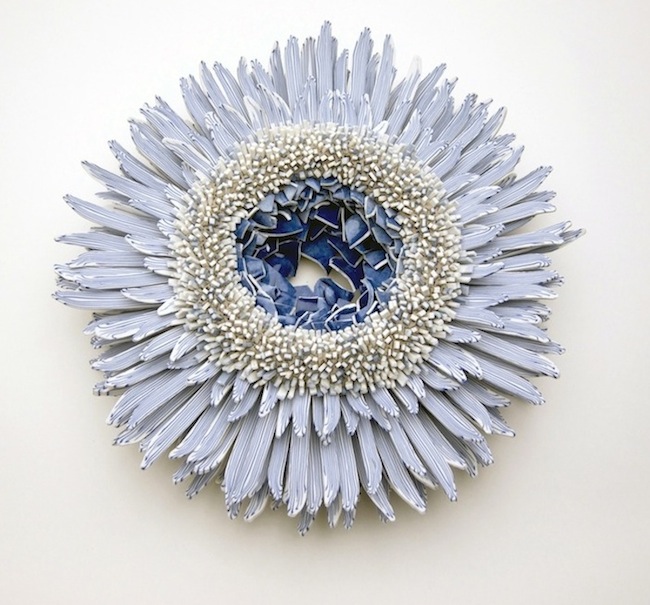Currently working as a resident at the Archie Bray Foundation for the Ceramic Arts, Zemer Peled creates fluid, organic sculptures from compiled shards of ceramic. She recently received the “highly commended” award by the Young Masters Ceramic Art Prize at the Cynthia Corbett Gallery and she exhibited new work at 108 Contemporary in Tulsa, OK.
Above image: Blue and White Porcelain Shards Flower 5 by Zemer Peled.
Peled’s sculpture is maturing rapidly, even since our previous coverage of her art less than a year ago, now confidently owning the visual origins of botany, further uniting form, concept and process.
CFile had the pleasure of sharing an interview with Peled to dig into her concepts, process, and aesthetic.

Blue and White Porcelain Shards Flower 3 by Zemer Peled.
CF: What is your educational background and what brought you to study art?
ZP: I completed my undergrad in Bezalel Academy of Art and Design in Jerusalem and my Masters at the Royal College of Art in London. I have been surrounded by art all my life, and was always encouraged by my parents to find my artistic path. Through most of my childhood, I danced and believed it would be “my thing”, but I “retired” during my army service in Israel and started exploring other artistic paths. I applied to Bezalel Academy of Art in Jerusalem, and very quickly realized that this is what I wanted to do.
CF: Your sculptures all have organic qualities and visually come across as abstracted plant forms. What is the influence behind your choice of imagery?
ZP: My work examines the beauty and brutality of the natural world and I’m inspired by nature and my surrounding landscapes. In my current body of work I’m influenced by the historically important era in ceramic history, the Blue and White Porcelain Wares, in particular the 19th century Blue and White floral and landscape designs painted on Japanese Igezara plates. Looking at the small paintings then enlarging and turning them into life-size sculptures, I would like the viewer to feel as if they are walking inside a blue and white porcelain plate. The pieces are made out of thousands of porcelain shards colored with blue cobalt.
CF: Can you tell me a little bit about your process for making these sculptures?
ZP: The sculptures I make are formed of ceramic shards, constructing them into large-scale/small-scale sculptures and installations. I am producing the shards myself using the slab roller; I make sheets of clay, fire them, and smash them into pieces with a hammer. I love playing with the idea of the texture and the form can look airy, delicate, light and fluffy and to give a sense of flutter, as if my breath would break it. Yet, the hard and sharp shards can be seen as round and moving, and give a sense of softness.

CF: Are there any other themes at work in your pieces?
ZP: Archeology is a huge interest of mine since I was a little child. Next to the Kibbutz where I grow up, in the north part of Israel, there is an archaeological site and as a child I used to go there a lot, digging in the ground and looking for cool shards! Moreover, I’m looking a lot at ancient ceramic objects and mosaics that were found in Israel, as reference for my work. One of my favorite places in Israel is the Archaeology Wing at the Israel Museum in Jerusalem. I am fascinated with the amount of history that is buried in my country and with the fact that wherever you go you can dig in the ground and find shards that tell you so much about the complex history of the land. In my work I’m creating and producing my own shards, giving my sculptures their own history and story.

CF: I really like how your work deals with destruction, creation, and sometimes the full circle back to destruction. Can you speak about that theme and how it functions in your work?
ZP: Process is crucial to my sculptural ideas. They are consistent with the Kabbalah concepts of Shevirah (breaking) and Tikkun (mending) that can also be considered as renewal. I make, then break, then make again. Chaos, destruction, and decay are intense and necessary creative process for me to create each of my sculptures.
The last answer was particularly meaningful to me. The issues of decay and chaos made me think of these woks as zombie flowers. Perhaps it was the ceramic bits and pieces as loose teeth (porcelain helps to enforce the metaphor) and face-eating flora. The flowers are the beauty to Little Shop of Horror’s beast. And this is what makes Zemmer’s art so compelling, it makes pretty threatening.
Justin Crowe is Writer-at-Large for CFile.
Any thoughts about this post? Share yours in the comment box below.

Zemer Peled, Pair by the Sea

Great article! It captures well Zemer’s depth, even with the article in such brief form. But because of it’s brevity, It doesn’t capture her warmth, compassion, and dedication to sharing her time and energy with us as her community and consumers of her work.
Wonderful interview and glorious work that I will be sharing with followers of Mosaic Art NOW. How marvelous that the childhood experience of picking up shards of ancient Roman mosaics on the ground has led her to this splendid place.